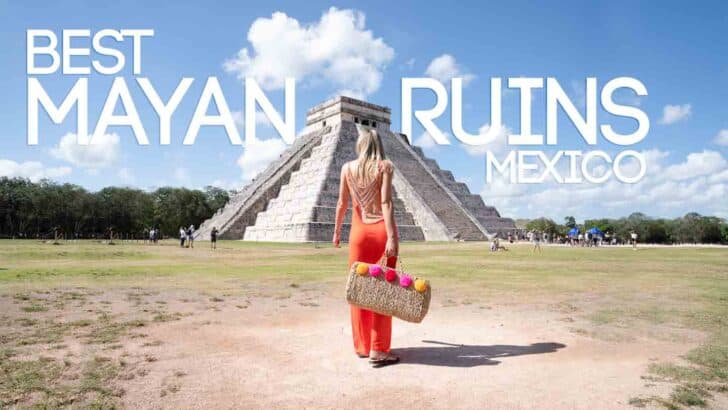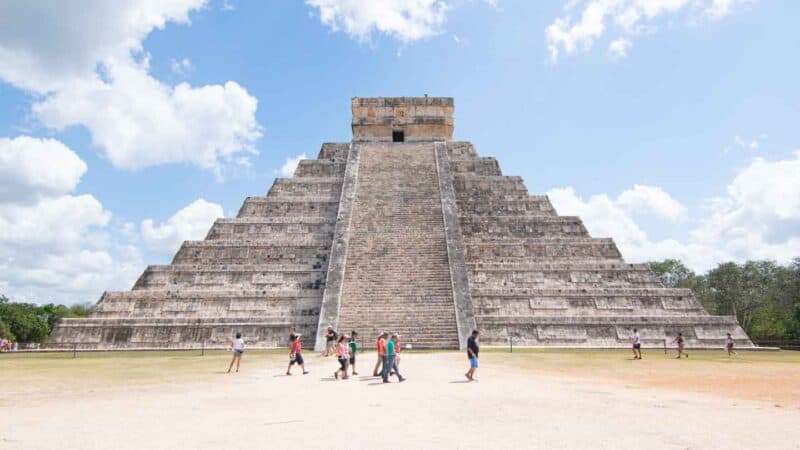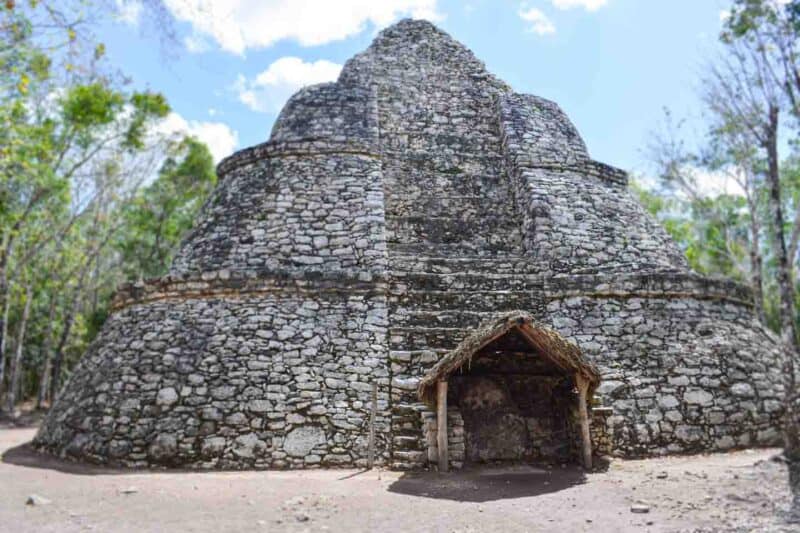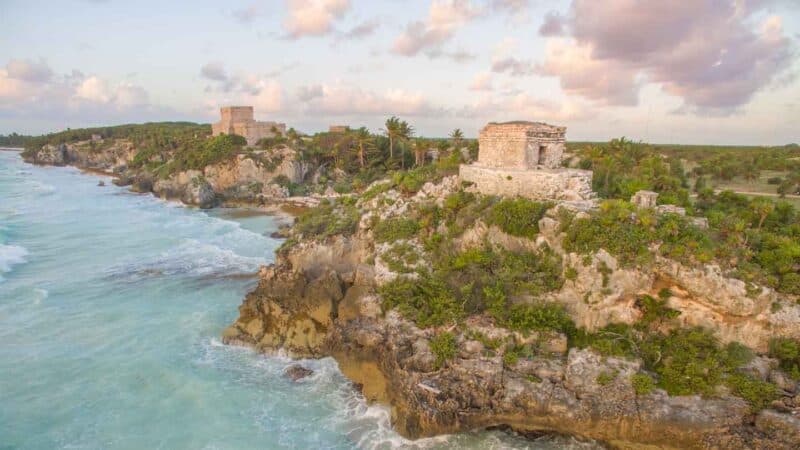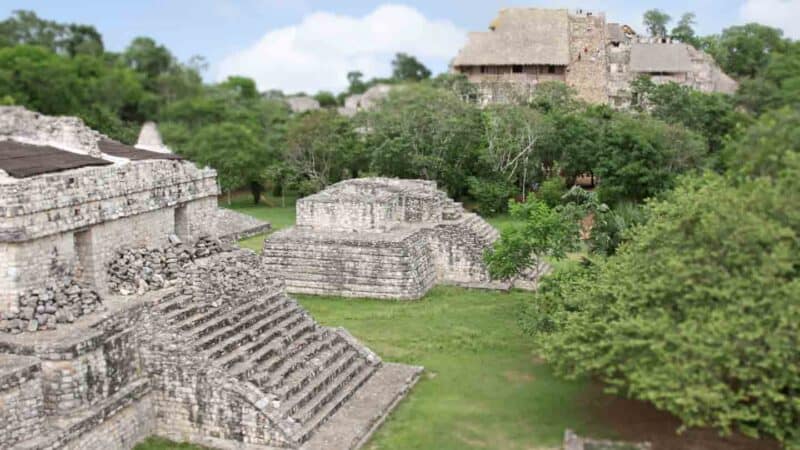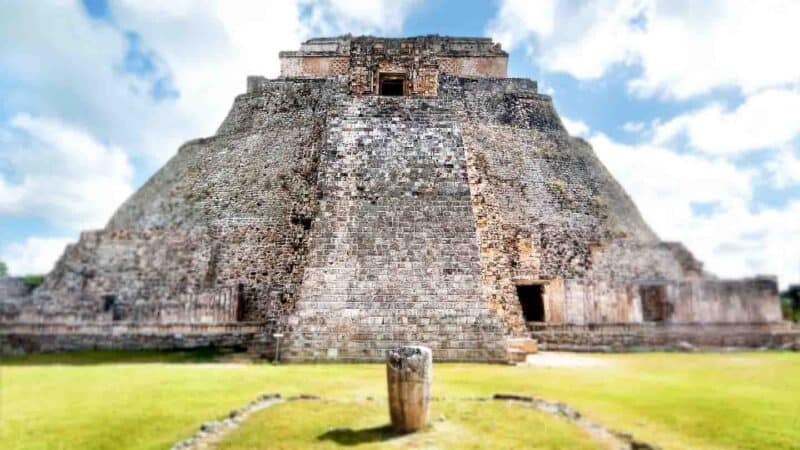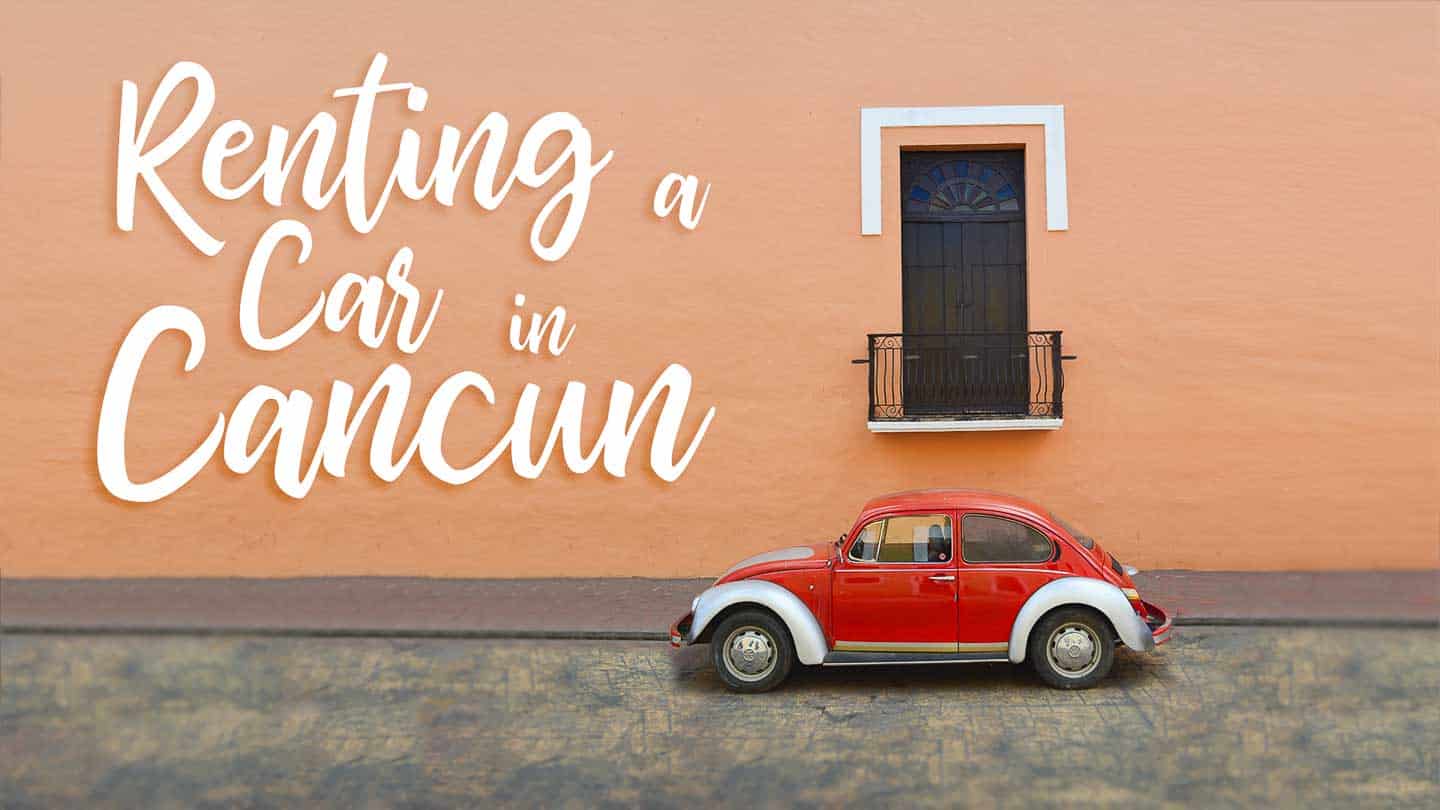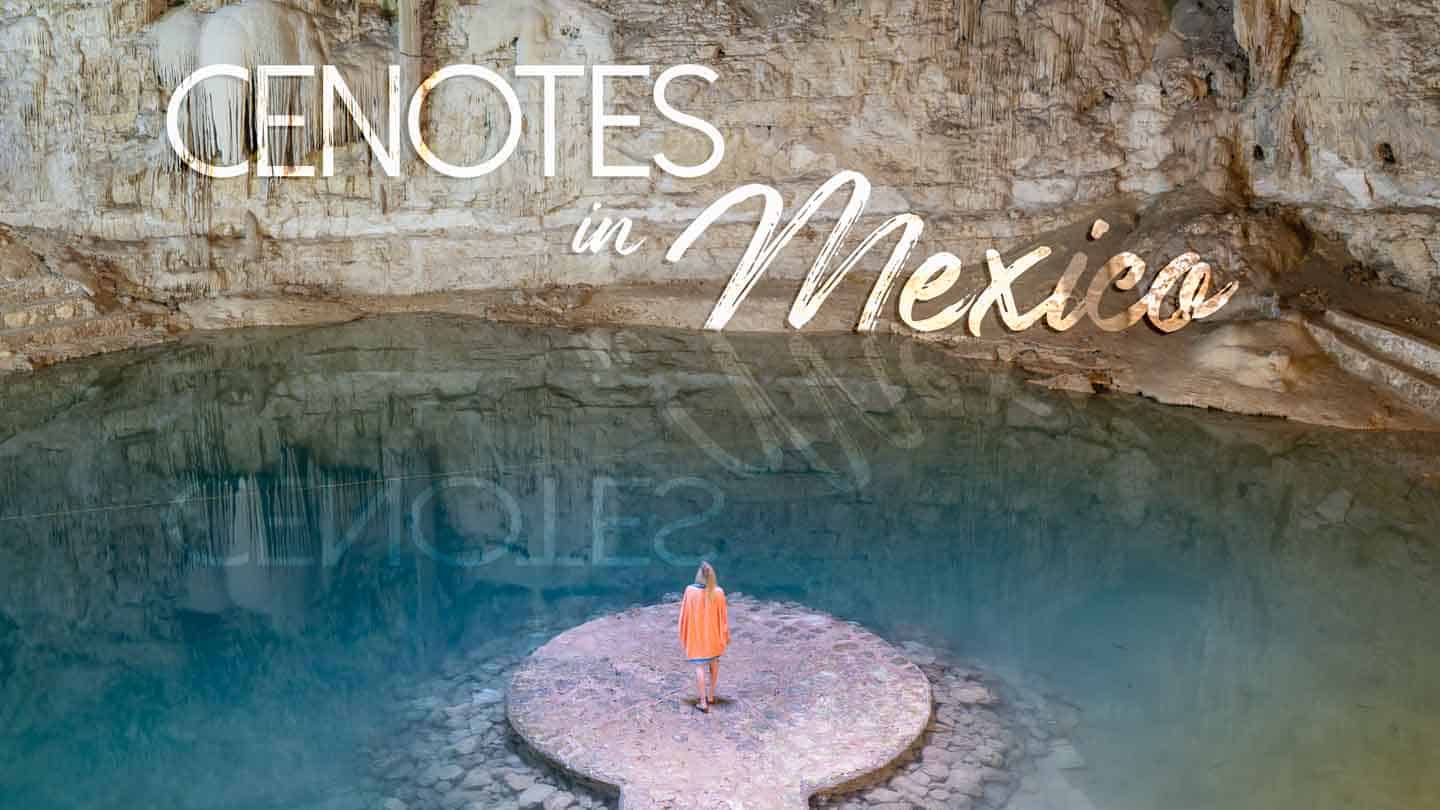Mexico is known for more than its sun-soaked beaches and festive atmosphere. You’ll find thousands of Mayan ruins throughout Mexico, many of which date back 2,500 years. Home to ancient civilizations, these Mayan ruins in Mexico are some of the best ways to explore Mexico’s history and culture.
Although different Mayan civilizations lived throughout the Americas, they prominently resided on the eastern side of Mesoamerica, or what we now know as Mexico. Some of the earliest Mayan settlements were found in 1800 BC; however, many cities came to power during the 6th century.
The Mayans left behind grandiose structures, beautiful art, and symbolic objects like pottery and jewelry. Nowadays, you can visit the deserted cities and Mayan ruins, which shed light on what life was like thousands of years ago.
Choosing between Mexico’s different ruins and sites can be a little overwhelming. However, there are some key places you must visit during your trip. In this article, we’ll cover a few of the best Mayan ruins in Mexico.
*When looking for the best price and biggest selection of hotels, check prices on Booking.com. We’ve found they are the best option and have a great cancelation policy.*
6 Best Mayan Ruins in Mexico To Visit
1. Chichen Itza Mayan Ruins
Considered one of the best Mayan ruins in Mexico, the archeological site of Chichen Itza is filled with history. Located on the Yucatan Peninsula, these Mayan ruins are just a short drive from Playa del Carmen and Valladolid. It’s also a three-hour drive from Cancun, making it the ideal day trip.
Not only is Chichen Itza a UNESCO World Heritage Site, but it was also voted one of the Seven New Wonders of the World. The impressive, sprawling complex dates back over 1,500 years and was once the economic and political capital of the Yucatan.
During the 9th century, Chichen Itza was home to over 50,000 residents, making it one of the largest Mayan cities at the time. However, many of Chichen Itza’s residents left for newer villages around Mexico. And in the 16th century, Spanish Conquestitors took over the city’s remaining. Between 1200 – 1500 AD, the city was eventually deserted.
The highlight of Chichen Itza is the towering El Castillo, a 100ft high step pyramid. It’s also referred to as the Temple of Kukulkan since it was built in honor of the feathered serpent deity, Kukulkan. Dominating over the rest of the ruins, a glimpse of El Castillo is worth visiting Chichen Itza alone.
Besides El Castillo, there are numerous other sites and temples to see in Chichen Itza. The Temple of Warriors is another magnificent structure. This stone pyramid is surrounded by 200 columns, with pictures of warriors carved into the side. At the top of the temple is a Chac Mool, a platform reportedly used for human sacrifices.
The sacred cenote is also one of the best things to see in Chichen Itza. This deepwater wall is located inside a cave surrounded by cliffs and rocks. While excavating the site, archeologists found treasures, jewelry, and even human remains at the bottom of the cenote. For this reason, it’s believed that the sacred cenote was used for religious sacrifices. If you don’t have time to visit the cenote, make sure to visit one of the other best cenotes in Mexico.
- Address: Carretera Federal, Cancun – Chetumal Km 230, 307, 77780 Tulum, Q.R., Mexico
- Hours: Every day from 8 am-5 pm
- Recommended Tour: Book Now – Viator Exclusive Early Access to Chichen Itza with Private Archaeologist
Related Article: Best Things to Do In Riviera Maya & Places to Visit
2. Coba Mayan Ruins
Tucked away from the city’s bustling crowds, Coba is an exceptional and historically significant archeological site. Located in the depths of a jungle, it may not be as busy or as popular as Chichen Itza or Tulum. However, its remote location makes it one of the best Mayan ruins in Mexico.
During its peak, Coba was home to over 50,000 residents. Historians believe that the first signs of human life date back to 100 AD. However, like many Mayan cities, Coba was soon abandoned during the invasion of Spanish conquistadors.
Once inside the Coba ruins, you’ll have several options for exploring the sprawling grounds. You can rent a bike or take a pedicab to reach the main sites and pyramids. Walking is an option but be prepared for a long journey.
The Coba ruins are known for ‘sacbes’ – or stone causeways. This intricate network of roads was widespread during the ancient Mayan world. The largest sacbes stretch for 62 miles and connect Coba with the ancient city of Yaxuná. It’s the longest and most technically engineered road of ancient life!
Besides walking on the sacbes, you can also visit Ixmoja, the largest pyramid in Coba. This structure can still be touched and climbed, unlike the ruins in Chichen or Itza. If you are wanting to climb a Mayan ruin in Mexico, you must come to Coba. Ixmoja stands 138 ft tall and has 120 stone steps. Once you reach the top, you’ll be rewarded with sweeping views of the surrounding lush jungle.
Another benefit to Coba’s rural location is its proximity to the limestone cenotes. There are three fresh-water cenotes near Coba, which means you can go for a swim or dip if the weather gets too hot! Our favorite cenote nearby is Suytun Cenote.
- Address: Carretera Federal Tulum 307, 77793 Cobá, Q.R., Mexico
- Hours: Every day from 8 am-5 pm
- Recommended Tour: Tulum, Coba, and Swimming in a Cenote – Book Now
3. Tulum Mayan Ruins
Dating back 700 years, the Tulum ruins are considered one of the best Mayan ruins in Mexico. The ruins are situated on the coast of Tulum, a charming port village in the Yucatan Peninsula.
Since it’s only a two-hour drive from Cancun, Tulum makes for an easy day trip. Here is our step-by-step guide for getting from Cancun to Tulum. If you are staying in Tulum, we suggest going early in the morning. The Tulum ruins are the most popular thing to do in Tulum, so go early or later in the afternoon.
Perched atop a cliff overlooking the Caribbean Sea, the archeological ruins of Tulum have a breathtaking setting. Although the walled city might not be as large or as impressive as other ruins in Mexico, its cliffside location makes up for it. There’s even a beach right in the middle of the ruins!
Many consider Tulum to be the smaller, more compact version of Chichen Itza. The temples of Tulum are built in the same style as the buildings in Chichen Itza and even mix different architectural influences.
Tulum was initially built as a sea fortress, hence the walled protection and lookout. During the height of its rule in the 13th and 14th centuries, Tulum was home to over 1,500 people. However, when Spanish conquistadors took over the town, they brought life-threatening diseases that killed most of the population.
However, Tulum was still considered one of the biggest trading ports in the Yucatan. Artifacts have been found throughout the site that originally came from Central Mexico and even Central America.
There are three significant structures to see in Tulum. The first building is El Castillo, which is similar in structure and style to Chichen Itza’s pyramid of the same name. Originally built as a lighthouse, this 25ft tall pyramid could see trading boats and canoes sailing towards the city.
The other two sites to see in Tulum are the Temple of the Frescoes and the Temple of the Descending God. Mayans used the Temple of the Frescoes as an observatory for tracking the sun’s movements. The Temple of the Descending God was used as a shrine to honor Tulum’s nameless “diving God.”
The cenotes near Tulum are some of the in Mexico, and my personal favorite is Cenote Calavera. It’s the perfect place to cool down after a hot afternoon exploring the best Mayan ruin in Mexico.
Go early in the morning. The heat is crazy hot at Tulum Ruins. Make sure to read our Tulum packing list for our tips on what to wear to Tulum Ruins.
- Address: Zona Hotelera de Chichen Itza, Chichen Itza, Yucatan, Mexico C.P. 97751
- Hours: Every day from 8 am-5 pm
- Admission Fee: 65 pesos per person
- Recommended Tours:
4. Ek Balam Mayan Ruins
Another popular ancient archeological site in the Yucatan Peninsula is Ek Balam. This walled city has an impressive 45 structures on-site, some of which you can even climb! There are very few ruins in Mexico you can climb, so make sure to put Ek Balam on your itinerary.
Its name roughly translates to “The Black Jaguar” in Mayan. Besides the sheer number of structures, the ruins are known for housing the tomb of El Balam’s ruler, Ukit Kan Leʼk Tokʼ.
From 770 – 840 AD, Ek Balam was one of the most prominent cities in the Mayan world. The town had around 20,000 people until its fall when the population dropped dramatically. Although there are many speculations as to why the Ek Balam was abandoned, it’s still not completely clear to this day.
Ek Balam is a relatively new discovery, with only its center having been excavated. However, many visitors come to see the Acropolis, which is the largest structure in the ruins. It’s believed to contain the tomb of Ukit Kan Leʼk Tokʼ, one of the biggest rulers of the time.
The entrance to his throne – known as El Trono – is shaped like a giant mouth. Many believe that it’s the mouth of a jaguar.
One of the best parts about Ek Balam is that you can climb to the top of the Acropolis. If you visit on a clear day, you might even be able to see the ruins of Coba and Chichen Itza from the top!
Another impressive feature of the Ek Balam ruins is the city walls. Ranging from 6.6 to 9.8 ft wide, these thick stone walls showcase how vital defense was to the city. The grounds of Ek Balam are vast, with the walls encompassing around 24 acres of land.
With dozens of buildings and structures to visit, it’s advised to spend several hours in Ek Balam.
- Address: Ek Balam, Yucatan, Mexico C.P. 97751
- Hours: Every day from 8 am-4 pm
- Recommended Ek Balam Tours
5. Uxmal Mayan Ruins
Considered one of the best Mayan ruins in Mexico, Uxmal is home to beautifully preserved and ornate structures. This ancient city is also located on the Yucatan Peninsula and was recently recognized as a UNESCO World Heritage Site.
The exact date and population of the city are still largely unknown. Many archeologists and historians believe Uxmal was built between 850-1100 AD and had around 15,000 residents. It is believed that the city ruled around 900 AD when it was the de facto capital of the Puuc region.
The city was soon abandoned after the Spanish conquest during the mid-1400 and 1500s. The original names of the structures are unknown since the Spanish gave them new titles based on their beliefs and thoughts about the buildings.
Although many buildings have been restored, Uxmal contains Mexico’s biggest collection of preserved ruins in Mexico. Many structures are built in Puuc-style, noted by their smooth slopes and thatched roof shapes.
The Governor’s Palace is one of the top things to see in Uxmal. This larger-than-life platform has a 320-foot-long mosaic carved with pictures of serpents, masks, and many god-like figures.
In Uxmal, you can also visit a large ball court, which was often used for playing Mesoamerican ball. Although most of the structure has deteriorated over time, you can still see the courts’ sides and the rings used to hold the balls.
Another notable structure is the Pyramid of the Magician, which dominates the skyline in Uxmal. Its rounded sides and elliptical base make it one of Mexico’s most unique structures. The pyramid gets its name from various folk legends told throughout Mayan history.
- Address: Uxmal, Yucatan, Mexico
- Hours: Every day from 8 am-4 pm
- Recommended Uxmal Tours
6. Labna
Don’t let the size of the small, compact ruins of Labna fool you. Recognized as a UNESCO World Heritage Site, this Mayan ruin has some of the finest Puuc-style structures. Along with Uxmal, it’s one of the last Puuc sites remaining in the Yucatan Peninsula.
During its reign between 600-900 AD, the city had a population of only 4,500 people. The site wasn’t discovered until it was discovered by English explorers Stephens and Catherwood in 1842.
As soon as you arrive in Labna, you’ll walk through the two-story-high Palace, which extends almost 400 feet in length. It’s considered one of the longest existing Puuc structures. The Palace also contains many ornate carvings inscribed inside the walls.
Even a large sculpture of Chac, the Mayan rain god, looms over you as you walk inside. However, you’ll find Chac masks throughout the entire site, especially in doorways and corners of the buildings.
Labna is also home to several sacbes, or paved roads. These roads connect the city to other villages and are considered one of the most advanced features of the ancient Mayan civilization.
The most popular sacbes extend from the Palace to the decorated arches, or “El Arco.” Many believe that the arch stands at the entrance of the city. However, it merely connects the main public plazas.
- Address: Carretera Uman – Hopelchen km 101, Mérida, Yuc., Mexico
- Hours: Every day from 8 am-5 pm
FAQ Mayan Ruins in Mexico
How many Mayan ruins in Mexico are there?
With over 4,400 Mayan ruins scattered throughout Latin America, many of the Mayan sites are located in Mexico.
What is the most famous Mayan ruin?
Chichen Itza is the most famous Mayan ruin in Mexico and one that shouldn’t be missed. Since it is the most famous Mayan ruin, it sees many visitors daily, so if you can rent a car and drive yourself to avoid the bus tours.
Which Mayan ruins to visit?
This will vary based on where you vacationing in Mexico and if you have a rental car in Mexico to drive yourself. You won’t be disappointed if you pick any of the above six best Mayan ruins in Mexico.
Which Mexican Mayan ruins can you climb?
There are still a few Mayan ruins you can climb in Mexico. Sadly you can no longer climb Chichen Itza, but you can climb the following Mayan ruins in Mexico: Coba Ruins and Ek Balam.
How old are the Mayan ruins in Mexico?
Evidence shows the Maya started building the Mayan ruins about 3,000 years ago.
Don’t forget to pin me for later!
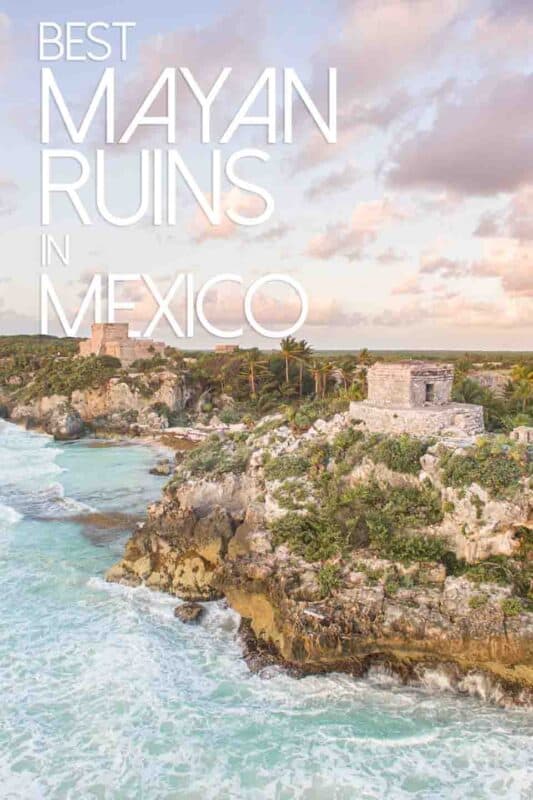
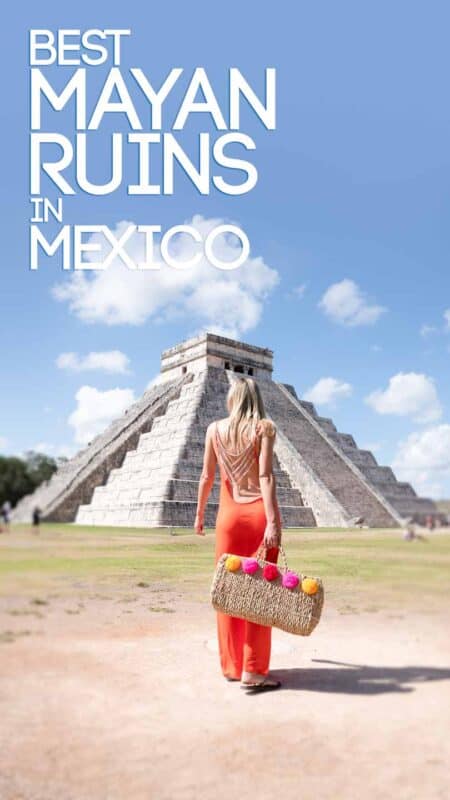
Is Isla Holbox worth the trip? YES! Holbox Mexico is one of the best places in Mexico to visit. Skip Tulum! 2024 Complete Holbox guide with things to do in Holbox, best restaurants, where to stay, how to get to Holbox, and more. Don’t rent a car in Cancun without reading this first! Cancun car rental guide: driving in Mexico tips, common scams, what to do if police pull you over, best rental car company, and more. Over 6,000 cenotes in Mexico, guide to the best cenotes in Tulum, Playa del Carmen, Merida & Cancun. Cenote map, entrance fees, hours & more.2024 Isla Holbox Ultimate Guide – Must KNOW Travel Tips
5 Things To Know BEFORE Renting a Car in Cancun
Ultimate List Of The Best Cenotes in Mexico
